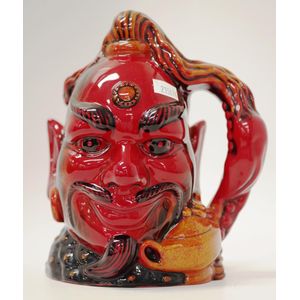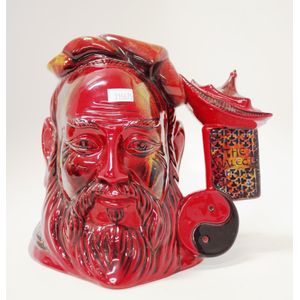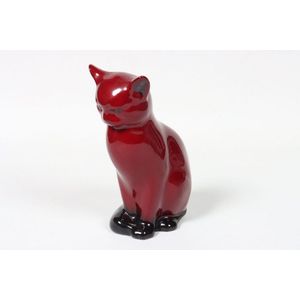
Royal Doulton Flambe Porcelain Figure: 'Eastern Grace', 32.5cm
A Royal Doulton flambe porcelain figure of 'Eastern Grace', height 32.5 cm

Antique Charles Noke Flambe Figurine "Despair" for Royal Doulton
An antique Charles Noke flambe figurine for Royal Doulton, "Despair", height 12 cm

Royal Doulton Flambe Zimbo Dragon Clock Limited Edition 24/250
Royal Doulton flambe Zimbo dragon clock BA37 Prestige Burslem Artwares, limited edition 24/250, 22.5 cm high

Royal Doulton Flambe Veined Standing Owl Figure - 31cm Height
Royal Doulton flambe veined standing owl figure height 31 cm

Royal Doulton Flambe Water Buffalo Figure Limited Edition 18/150
Royal Doulton flambe water buffalo figure BA59, limited edition 18/150, width 28 cm

Vintage Thimbles Lot: Royal Doulton, Sterling Silver, Caithness & More
Seven various vintage thimbles including Royal Doulton Flambe, sterling silver and Caithness

Large Royal Doulton Flambe Rhinoceros by Leslie Harradine, 39cm
Rare large Royal Doulton Flambe Rhinoceros designed by Leslie Harradine, width 39 cm

Royal Doulton Flambe Elephant and Young Figurine HN3548 12.5cm
Royal Doulton Flambe elephant and young HN3548 12.5 cm long

Royal Doulton Flambe 'The Wizard' Figurine - HN3121 - 25cm
Royal Doulton Flambe 'The Wizard' figurine HN3121, height 25 cm

Royal Doulton Flambe Tiger Stalking Figurine HN1082 - 34cm
Royal Doulton Flambe tiger stalking figurine HN1082, width 34 cm

Royal Doulton Flambe 'Eastern Grace' Limited Edition Figurine 190
Royal Doulton Flambe 'Eastern Grace' figurine HN3683, limited edition 190, height 31.5 cm

Royal Doulton Flambe Dragon Figurine, Vein Red, 26cm Width
Royal Doulton Flambe 'Vein red Dragon' marked to base, width 26 cm

Royal Doulton Flambe Egg and Stand Limited Edition Collectible
Royal Doulton flambe egg and stand Limited edition 2346 /3500, 14 cm high

Royal Doulton Flambe 'Motherhood' Figurine - HN3464, 22 cm Height
Royal Doulton Flambe 'motherhood' figurine from the images of fire series HN3464, height 22 cm

Royal Doulton Flambe 'The Moor' Limited Edition Figurine
Royal Doulton Flambe 'The Moor' figurine HN3642, limited edition 105, signed to base, height 43 cm

Royal Doulton Flambe Aladdin's Genie Character Jug Limited Edition
Royal Doulton Flambe Aladdin's Genie character jug D6971, limited edition no: 817, height 19 cm

Royal Doulton Flambe Veined Cat Figure - 30 cm Tall
Royal Doulton Flambe veined cat figure height 30 cm

Royal Doulton Flambe Guinea Fowl Figurine, 11.4 cm Long
Royal Doulton Flambe Guinea Fowl HN 125 11.4 cm long

Royal Doulton Flambe Pair of Foo Lions, 12 cm Height
Royal Doulton flambe pair of foo lions, height 12 cm

Royal Doulton Flambe Porcelain Cat Statue, 13 cm High
Royal Doulton 'Flambe' porcelain cat statue, black factory mark to base, 13 cm high

Rare Large Antique Doulton Flambe Rhinoceros Figure, Veined Marked Base
A rare large antique Doulton flambe animalier figure of a rhinoceros marked to base veined flambe, height 23 cm, length 41 cm D17 cm

Royal Doulton Flambe Fox Statue: English Porcelain, 11cm High
Royal Doulton 'Flambe' English porcelain fox statue, stamped 'Royal Doulton, flambe, made in England', 11 cm high,

Rare Royal Doulton Flambe Cat Figurine by A. M. Maslankowski
Large Royal Doulton Flambe cat figurine with printed mark in black, initialled A. M. Alan Maslankowski, circa 1973-1996, 29.5 cm high

16 cm Royal Doulton Flambe Woodcut Shallow Dish - Scratched
Royal Doulton Flambe woodcut shallow dish width 16 cm, scratched

Limited Edition Flambe Eastern Grace Figurine by Royal Doulton
Royal Doulton flambe Eastern Grace figurine limited edition, HN 3683, modelled by P Parsons, 31.5 cm high with certificate

Limited Edition Royal Doulton Aladdin's Genie Toby Jug
Royal Doulton Aladdin's Genie flambe toby jug D6971, limited edition 921, together with certificate, height 19 cm

Limited Edition Royal Doulton Confucius Toby Jug
Large Royal Doulton Confucius flambe toby jug D7003, limited edition 496, together with certificate, height 19.5 cm

Royal Doulton Flambe Carpet Seller Figurine HN3277
Royal Doulton flambe carpet seller figurine HN3277, height 19.5 cm

Limited Edition Royal Doulton Flambe Pharaoh Toby Jug
Large Royal Doulton flambe the pharaoh toby jug D7628, limited edition 446, together with certificate, height 18 cm

Flambe Elephant and Young Figurine by Royal Doulton
Royal Doulton flambe elephant and young figurine HN3548, width 12.5 cm

Royal Doulton Flambe Geisha Figurine - 24cm Height
Royal Doulton flambe Geisha figurine HN3229, height 24 cm

Royal Doulton Flambe Duck Miniature Figure
A Royal Doulton miniature flambe figure of a duck, height 7 cm

Royal Doulton Flambe Duck Figure (16 cm)
Royal Doulton flambe duck figure marked to base, height 16 cm.

Graduated Royal Doulton Flambe Duck Figures (2)
A graduated pair of Royal Doulton flambe duck figures, height 15 and 16 cm. (2)

Flambe Three Wise Monkeys Artware by Royal Doulton
A Royal Doulton Burlsem Artwares flambe animalier group, 'Three wise Monkeys', BA64, modelled by Martyn Alcock, edition number 49 of 250, issued 2005, height 14 cm. Signed by Michael Doulton to base.

Royal Doulton Flambe Figure: The Carpet Seller
A Royal Doulton flambe figure, 'The Carpet Seller', HN 3277, designed by Robert Tabbenor, issued 1990-95. Height 18 cm.

Royal Doulton Flambe Figure: The Carpet Seller
A Royal Doulton flambe figure, 'The Carpet Seller', HN2776, designed by William K. Harper, height 24 cm.

Flambe Lamp Seller Figure by Royal Doulton
A Royal Doulton flambe figure, 'The Lamp Seller', HN3278, designed by Robert Tabbenor, issued 1995. Height 23 cm.

Royal Doulton Flambe Fox Figurine, Circa 1920-29
A Royal Doulton flambe fox, model no.102, circa 1920 - 29. Height 23 cm.

Royal Doulton Flambe Water Buffalo Figure
A Royal Doulton flambe animalier figure, 'Water Buffalo' BA59, from the Burslem Artwares, with 100th Anniversary backstamp and numbererd 37 of 150, height 17 cm.

Royal Doulton Year of the Pig Figure
A Royal Doulton flambe animalier figure, '2007 Year of the Pig' BA78, from the Burslem Artwares, numbered 27 of 150, height 14 cm.

Harry Nixon's Sung Ware Pot Pourri Jar
A large Royal Doulton 'Sung' Ware pot pourri jar decorated by Harry Nixon, early 1920s, of compressed barrel shape with a pierced silver plate cover, the flambe-glazed body decorated all round with flowers in deep purple, red, and other colours within…

Royal Doulton Flambe Porcelain Duck - 16.5cm
A Royal Doulton red flambe porcelain duck, black factory mark to base, 16.5 cm high

Noke Flambe Elephant Model and Arabian Posy Pot
Royal Doulton Noke flambe elephant model & posy pot, Noke signature to foot of elephant together with small Arabian pattern flambe posy pot, 16 cm L and 6 cm high

Limited Edition Royal Doulton Flambe Elephant - Shanxi
A Royal Doulton Burslem Archives 'Shanxi' flambe elephant, limited edition 24/250 Burslem BA42

Pair of Royal Doulton Flambe Veined Owl Statues
Royal Doulton 'Flambe Veined' pair of owl statues, stamped 'Royal Doulton, England, made in England, flambe Veined', 29 cm and 30 cm high

"The Geisha" Flambe Porcelain Figure - 24cm
Royal Doulton flambe porcelain figure, depicting 'The Geisha', standing elegantly and holding a fan to chest, height 24 cm

Flambe Monkey Duo Figurine by Royal Doulton
Royal Doulton flambe figure of two monkeys height 7.5 cm

Royal Doulton Flambe Dragon Plate
A Royal Doulton 'Burslem Archives' flambe 'Fu Wei Dragon' (2005), width 19.5 cm. Historic retail $NZ765

Limited Edition Royal Doulton Year of the Pig Figurine
A Royal Doulton flambe glaze Burslem Artwares '2007 Year of the Pig', limited edition, BA78, number 34 of 150, modelled by Alan Maslankowski, with certificate, length 19 cm. Historic retail $NZ1400.

Royal Doulton Flambe Sheng Chi Tiger Figurine
A Royal Doulton 'Burslem Archives' flambe 'Sheng Chi Tiger' (2005) Model BA66, length 20 cm. Historic retail $NZ765

Limited Edition Royal Doulton 'Three Wise Monkeys' Sculpture
A Royal Doulton 'Burslem Archives' flambe glazed model 'Three Wise Monkeys', by Martyn Alcock, limited edition, number 30 of 250, with certificate. Model BA64, width 17.5 cm. Historic retail $NZ2415

Royal Doulton Qingdao Charger Plate, Limited Edition
A Royal Doulton Burslem Artwares limited edition 'Qingdao Charger Plate', Sung glaze, number 046 of an edition of 200, diameter 34 cm. Historic retail $NZ3595.

Royal Doulton Flambe Figure: Eastern Grace
A Royal Doulton flambe glaze figure, 'Eastern Grace', designer Pauline Parsons (1996) Limited edition 1947/2500. HN3683. Not original box, height 32.5 cm.

Royal Doulton Flambe Genie Figure by Tabbenor
A Royal Doulton flambe glaze figure 'The Genie', modelled by Robert Tabbenor (1982), HN2999, height 25 cm.

Royal Doulton Geisha Figure by Pauline Parsons (1989)
A Royal Doulton flambe glaze figure 'The Geisha', modelled by Pauline Parsons (1989), HN3229, modelled for the Collectors Club, height 24.5 cm

Limited Edition Royal Doulton Samurai Warrior Figure
A Royal Doulton flambe glaze figure 'Samurai Warrior, modelled by Robert Tabbenor (1992), limited edition, number 389 of 950, height 22 cm (excluding sword).

Limited Edition Sung Glazed Fu Dogs by Royal Doulton
A pair of limited edition Royal Doulton 'Qinghai Fu Dogs', modelled by Alan Maslankowski, Sung glazed, number 204 of an edition of 250, with certificate, height 18 cm. Historic retail $NZ3600

Early Royal Doulton Flambe Owl Lamp Base
Rare Royal Doulton flambe owl lamp base early flambe mark to base. 21 cm high not including lamp C:1920

Flambe Country Trio Collection
Six Royal Doulton flambe trios all decorated with English country scenes

Flambe Jug with English Cottage Scene
Royal Doulton flambe jug decorated with a English cottage scene

Royal Doulton Flambe Fox Figurine, 11 cm
A Royal Doulton flambe fox, seated with tail curled around its front. In production 1912 - 1996, height 11 cm.

Royal Doulton Flambe Cat Figurine
A Royal Doulton flambe cat, in production c1925 - c1990. Designed By Charles Noke, stamped Royal Doulton, England, Flambe, made in England, height 13 cm.

Royal Doulton Flambe Egg with Box and Certificate
A Royal Doulton flambe egg RN684, in original display box with authentication certificate, height 17 cm

Royal Doulton Flambe Duck Model No. 654
A Royal Doulton flambe duck model no. 654. Incised no 10 on base Rd flambe stamp. 9.5 x 18.5 cm

Royal Doulton Flambe Stalking Fox Sculpture
A large Royal Doulton flambe stalking fox, signed Noke (under the tail) Doulton stamp and flambe stamp beneath paws, length 30.5 cm

Doulton Hispano-Moresque Charger by John Slater, c.1890
A Doulton 'Hispano-Moresque Ware' charger, attributed to John Salter, c.1890 decorated with a mermaid and harnessed seahorses and fish, crimson lustre glaze highlighted with gilt on a brown-black ground, earthenware, designed by John Slater, made by…

Royal Doulton Flambe Desert Scene Table Lamp
Good Royal Doulton flambe electric table lamp decorated with a Desert Scene on flambe ground, marked to base, height 32 cm.

Royal Doulton Sunflower Cottage Flambe Ink Pot
Royal Doulton flambe ink pot sunflower cottage scene, 605 cm height

Damaged Royal Doulton Flambe Tern Bird, 21cm
Rare Royal Doulton flambe bird, Tern 21 cm length, as inspected tail badly repaired, beak missing

Flambe Emperor Penguin by Royal Doulton
Royal Doulton flambe emperor penguin, beautifully modelled seabird in rich red and Burgundy flambe colourway with underglaze feather decoration to back

Royal Doulton Flambe Dish with Middle Eastern Scene
Rare Royal Doulton flambe 'demi-lune' dish decorated with Middle Eastern Scene with Camel, marked to base, filled rim chip lower left, diameter 14.5 cm

Royal Doulton Flambe Tiger Figurine - 14cm height
Tiger, printed mark, 'Royal Doulton Flambe' to base, height 14 cm

Royal Doulton Flambe Welsh Dragon Special Edition Figurine
Flambe Welsh Dragon, printed mark, 'Royal Doulton' to base, Special Edition No 1441 of 1500, height 13 cm

Royal Doulton Flambe Sitting Cat Figurine (13cm)
Sitting Cat, printed mark, 'Royal Doulton Flambe' to base, height 13 cm

Royal Doulton Flambe Carpet Seller Figurine
The Carpet Seller, printed mark, 'Royal Doulton Flambe HN3277' to base, height 19 cm

Royal Doulton Flambe Teacup and Saucer
Teacup and Saucer, printed mark, 'Royal Doulton Flambe' to base, height 6.5 cm

Royal Doulton Flambe Tray, Signed by Noke
Tray, printed mark, 'Royal Doulton Flambe', Signed by Noke, Width 7 cm

Royal Doulton Flambe Veined Plate - 16.5cm
Plate, printed mark, 'Royal Doulton Flambe Veined 1621' to base, Diameter 16.5 cm

Flambe Fat Boy Figurine by Royal Doulton
Flambe Fat Boy, printed mark, 'Royal Doulton' to base, height 11 cm

Flambe Tiger by Royal Doulton - 14cm
Tiger, printed mark, 'Royal Doulton Flambe' to base, height 14 cm

Royal Doulton Flambe Elephant Figurine - 14cm
Flambe elephant, printed mark, 'Royal Doulton' to base, height 14 cm

Flambe Sitting Cat by Royal Doulton
Sitting Cat, printed mark, 'Royal Doulton Flambe' to base, Signed Michael Doulton 1985, height 13 cm

Royal Doulton Flambe Elephant Figurine - 16cm Height
Elephant, printed mark, 'Royal Doulton Flambe' to base, height 16 cm

Royal Doulton Flambe Darling Figurine
Flambe 'Darling', printed mark, 'Royal Doulton' to base, height 13 cm

Flambe Couple Figurines by Royal Doulton
Flambe Man & Woman, printed mark, 'Royal Doulton' to base, height 31 cm

Royal Doulton Flambe Elephant and Young Figurine
Elephant & Young, printed mark, 'Royal Doulton Flambe HN3548' to base, height 9 cm

Flambe Sitting Cat by Royal Doulton - 12cm
Sitting Cat, printed mark, 'Royal Doulton Flambe' to base, height 12 cm

Royal Doulton Flambe Elephant Figurine, 11cm
Elephant, printed mark, 'Royal Doulton Flambe' to base, height 11 cm

Royal Doulton Flambe Elephant & Young Figurine
Elephant & Young, printed mark, 'Royal Doulton Flambe HN3548' to base, height 9 cm

Royal Doulton Flambe Carpet Seller Figurine
The Carpet Seller, printed mark, 'Royal Doulton Flambe, HN2776' to base, height 24 cm





 Loading more...
Loading more...